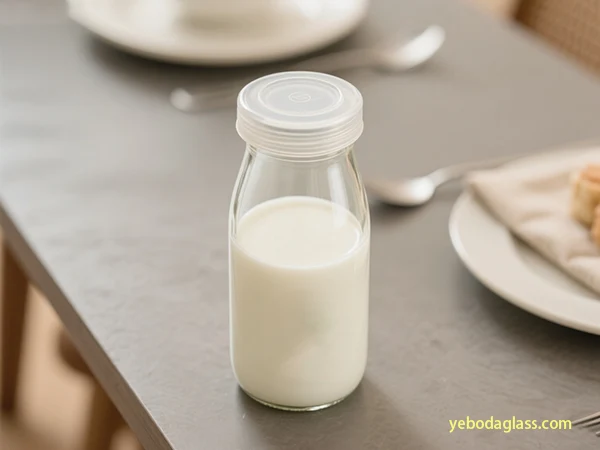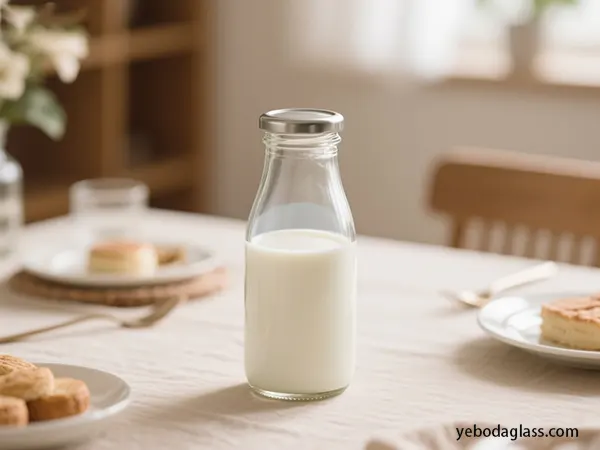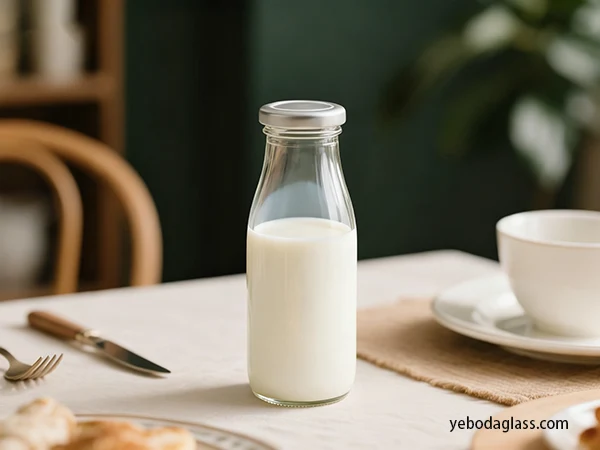Введение
glass packaging are becoming very different from what they have been in the last few years. The alterations are mostly attributed to the requirements for less-polluting practices, fresh substances, and consumer-values that keep on changing. Actually, the functionally ecologically-oriented milk bottle factory will be the one of the future. Glass milk bottle factory activities will practically comprise mostly recycled content, bioplastics, and the return of such materials as glass – besides other things like automation, AI-driven analytics, and supply chain intelligence by 2026. Packaging is the most visible part of the brand that is now getting redefined for the brand to keep its environmentally friendly credentials. The planned milk bottle factory will not only be a basic production facility; it will be a center of innovation, efficiency, and sustainability. Market Overview of Milk Bottle Factory

The demand for glass packaging and environmentally friendly milk packaging is increasing in both the traditional dairy and plant-based sectors. The main factors that fuel this market are population growth, increase in disposable incomes, and diversification of dietary preferences.
The industry is bifurcated into two different paths:
Traditional dairy milk remains the primary source of nutrition for the population of the developing countries.
- Plant-based alternatives like oat, almond, soy, and pea protein milks are gaining popularity all over the world.
- Both dynamics require milk bottle factories to have agile manufacturing and innovative bottle designing in order to be able to compete.
Key Market Dynamics
Changing Consumer Values:
- The changes in consumer behavior that have led sustainability, transparency and health-consciousness to be some of the main characteristics of the core behaviors, which thus, have an impact on the buying decisions. Regulatory Pressure:
- Authorities have imposed strict regulations for effective management of plastic waste and the usage of recycled materials. Technological Disruption:
- The application of AI, IoT, and robotics, which are some of the Industry 4.0 features, to the manufacturing sector is a core-level change of the manufacturing is the way. Supply Chain Flexibility:
- The difficulty in post-pandemic logistics has greatly contributed to the need for local sourcing and production flexibility. The Decision is Quite Obvious:
- any milk bottle factory must keep on changing its materials, operations, and designs if it wants to survive in this constantly changing global market. Material Innovation & Sustainable Packaging Solutions
Environmental aspect is the chief factor which is pushing the material innovations in milk bottle factory operations worldwide. In 2026, factories will produce a variety of environmentally friendly materials that will be a combination of cost, feature, and environmental impact.
Glass Packaging: The Resurgent Champion
Glass is gaining back a lot of its former popularity, especially with the case of premium dairy and organic product segments. What makes it a must-have material is its compatibility with today’s sustainability principles.
Recycling without Limit:
- Unlike plastics, glass can be recycled an unlimited number of times without any degradation of the material. Purity and Inertness:
- Glass is a non-porous and chemically inert material, thus it does not contaminate milk. Luxury Brand Appeal:
- The use of glass milk bottle raises the product’s image and is in line with consumer expectations of quality and health. The beauty of glass is one of the reasons why it is easier to gain trust and allow more visibility in retail stores.
- Прозрачность: Advantages of Modern Glass Production
Branding embossed on the product or unique shaped containers, personalization helps the brand to be recognized.
By using exact technology, it is now possible to produce glass containers that are thinner yet stronger, thus both the material and the environment are conserved.
- Персонализация: More recycled glass is incorporated into production, waste heat is captured, and water systems are closed which contributes to the reduction of the process’s carbon footprint.
- Облегчение: Through obtaining ISO 22000 and HACCP certifications, a modern glass milk bottle factory is a pledge of global food safety standards.
- As a consequence, they cut down on their costs and at the same time, they keep winning consumer trust and their brand’s worth in the long run. Plastic Packaging: Evolution Toward Circularity
- Though glass has been gaining traction, plastic packaging remains essential for still due to its lightness and affordability. However, the new milk bottle factory is all about circular innovation: Recycled Content Integration (rPET, rHDPE):
Conforming to international standards for the usage of recycled materials.

Design for Recyclability:
The use of single-material structures and the transparency of PET make the recycling process easier.
- Bioplastics: Some potential biomaterials like PLA and bio-PE that could provide a completely renewable are gradually being introduced.
- Chemical Recycling: Использование структур из одного материала и прозрачность ПЭТ облегчают процесс переработки.
- The milk bottle factory becomes more environmentally and financially sustainable with each step, thus the industry is getting closer to a fully circular model. 2025年10月23日
- R&D keeps searching beyond glass and plastic for: Paper-Based Bottles:
A completely renewable source but having some limitations in terms of durability.
Compostable Polymers:
Environmentally friendly materials, but their use is highly dependent on the availability of the industrial composting sector.
- Refill/Reuse Systems: Circular consumption models that are gaining popularity among premium brands.
- The milk bottle factory of tomorrow needs to be material-agnostic, yet environmentally friendly and technologically advanced to handle market and tech changes. Advanced Production Technologies and Automation
- Industry 4.0 is the era of digital transformation that is revolutionizing every milk bottle factory with precision, efficiency, and sustainability being the main features. Milk Bottle Factory Automation and Robotics
Robotic Handling Systems:
Material flow can be optimized, labor requirements decreased, and product quality consistency can be confirmed through the use of these systems.
Automated Optical Inspection (AOI):
Implements AI to find the smallest defects in glass types.
- AGVs and AMRs: Self-directed transport robots upgrade the internal logistics line by line safety getting better at the same time.
- An advanced milk bottle factory is fully automatic, so the entire production process from melting and forming to packaging and warehousing is done automatically. Energy Efficiency and Sustainable Operations
- New factories create maximum value out of all resources they use: Energy Recovery:
The energy that is lost as hot air from furnaces is used again to heat materials that are preheated.
Renewable Energy Adoption:
The usage of solar and wind energy help to reduce carbon emissions.
- Water Recycling: Closed-loop systems ensure that water consumption remains very low.
- Thanks to all these facilitation, every milk bottle factory is aligned with sustainability frameworks such as ISO 14001. Data Analytics and Industry 4.0 Integration
- IoT sensors: They make possible to monitor temperature, pressure, and other quality parameters in real-time.
AI & Predictive Maintenance:
Is a tool that keeps the machine going, hence, the service life is extended.
- Digital Twins: Give the factory the capability to conduct simulations for productivity optimization.
- Helps to build customer confidence by providing Supply chain transparency. After implementing digital transformation to the fullest extent, the milk bottle factory is a smart, interconnected production ecosystem.
- Functional, Aesthetic, and Smart Bottle Design Trends Bottle design is now strategic, integrating consumer psychology, ergonomics, and sustainability.
- Отслеживаемость блокчейна: Designers in every milk bottle factory focus on:
Grip Comfort:
Curved forms for better handling.
Pour Control:
Anti-drip spouts for cleanliness.
Ease of Opening:
- Secure yet user-friendly caps for all demographics. These small improvements significantly enhance user satisfaction.
- Aesthetics and Brand Differentiation Modern brands demand packaging that tells a story:
- Minimalist Elegance: Clean shapes and simple labels signal purity.
Embossed Branding:

Reinforces authenticity.
Green or transparent
- communicate freshness and trust. A skilled milk bottle factory collaborates with design teams to merge form and function, reinforcing the brand’s environmental narrative.
- Smart Packaging Technologies Connectivity is the next wave of glass milk bottle design:
- Психология цвета: Help customers to see the origin of the product, obtain the sustainability information, and get engaged in the interactive experiences. стеклянные бутылки Help customers to see the freshest milk visually.
RFID Integration:
Improves supply chain transparency and makes counterfeiting more difficult.
These types of innovations convert normal bottles into smart communication devices that help not only to increase brand engagement but also to raise consumer trust levels.
- Regulatory Landscape and Consumer Behavior The operations of milk bottle factories are influenced by government regulations and consumer sentiment, which can be regarded as two equally important factors.
- Regulatory Frameworks Plastic Waste Directives:
- A set of measures aimed at mandatory recycling and content quotas. The producers are responsible for the products’ end-of-life that they have put on the market.
Food Contact Regulations:
Safety standards set for recycled plastics and glass milk bottles.
Labeling Standards:
The main idea is the commitment of labeling to provide accurate sustainability-related information in order to prevent greenwashing.
- Each milk bottle factory has to adjust to these rules that are constantly changing in order to be in compliance and keep their brand integrity. Consumer Preferences
- Intermodal Transport: Environmentally Friendly Packaging:
- Consumers opt for easily recyclable glass bottles and rPET containers. Honesty:
- QR-based traceability of milk origin. Return and Reuse:
Circular systems are becoming more and more popular.
Those factories that are able to foresee these preferences will remain loyal to them in the future.
Strategic Implications for Industry Stakeholders
- The changing packaging environment has implications in terms of risks and opportunities for the stakeholders of the industry. For Bottle Manufacturers
- Enable multi-material flexibility through investments in the milk bottle factory. Focus on AI and automation to improve your operational resilience.
- Create packaging that is both recyclable and reusable. Make use of environmental certifications to establish trust and gain credibility.
For Dairy and Plant-Based Producers
Use diverse packaging portfolios as an advantage rather than a problem.
Collaborate with bottle suppliers on new product development to create value for both parties and customers.
On the positive side, sustainability efforts can be a great marketing tool.
- Figure out circular solutions and create partnerships that facilitate a closed-loop system.
- For Equipment Suppliers
- Prepare for the future by constructing adaptable, energy-saving machines that can work with the newest material types.
- Use the IoT and other control systems for machine integration and process optimization.
Offer complete automation and service packages to milk bottle factory clients whose business is continually changing.
- Conclusion & Future Outlook
- Traditionally the milk bottle factory has been a local production unit but now it is on its way to becoming a technological as well as an environmentally-friendly power center. The industry will be able to combine profit-making with ecological sustainability through embracing principles of circular economy, automating processes, and designing alongside that awareness.
- The Path Ahead
- Hyper-Personalization:
With 3D-printed molds, we might soon see formerly anonymous bottled become personalized editions for target groups.
- Material Hybridization:
- The best of glass, paper, and bio-based plastics being merged to provide both superior and eco-friendly feature.
- Smaller-scale recycling loops that are geographically closer to each other thus lessening waste production.

AI-Driven Design:
The use of AI to forecast how to get the best strength-to-weight ratio in material can lead to significant savings.
Global Regulatory Alignment:
- Easier conformity which in turn positions the business to undertake the sustainable scene more rapidly. So, glass milk bottle manufacturing isn’t just a matter of production anymore; in fact, it is a pretty significant model for the way ecological packaging will look in the future whereby each milk bottle factory is delivering not only commodities but also making a valuable contribution towards a cleaner, smarter, and more circular global economy.
- Material Hybridization: The best of glass, paper, and bio-based plastics being merged to provide both superior and eco-friendly feature.
- Закрытые циклы: Smaller-scale recycling loops that are geographically closer to each other thus lessening waste production.
- AI-Driven Design: The use of AI to forecast how to get the best strength-to-weight ratio in material can lead to significant savings.
- Global Regulatory Alignment: Easier conformity which in turn positions the business to undertake the sustainable scene more rapidly.
So, glass milk bottle manufacturing isn’t just a matter of production anymore; in fact, it is a pretty significant model for the way ecological packaging will look in the future whereby each milk bottle factory is delivering not only commodities but also making a valuable contribution towards a cleaner, smarter, and more circular global economy.




